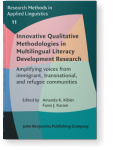Chapter 6
Korean American children’s voices in translanguaging Play-Based
Family Literacy (PBFL) through the suda (수다) approach
In this chapter we propose suda
(수다) [suda is a type of
conversation similar to small talk, but it entails a significant
length of time with several emergent stories in Korean culture] as a
tool for rethinking theory and methodological innovation in
qualitative research, emphasizing culturally responsive and
sustaining perspectives through examining Korean American children’s
translanguaging Play-Based Family Literacy (PBFL) at home during the
COVID-19 pandemic. This chapter focuses on how our rethinking of
suda to include the voices of multilingual
children as well as researchers themselves can be an innovative
qualitative research tool that facilitates the examination of PBFL
practices, which encourage natural literacy practices within play
contexts, diverging from traditional school-like literacy
activities. Introducing how suda is utilized as
data collection and analysis, this study also presents implications
of rethinking suda for culturally responsive and
sustaining research that can amplify the voices of multilingual
children and researchers in the context of translanguaging PBFL
practices. Our findings also highlight the importance of PBFL
practices for early childhood development and literacy research.
Article outline
- Introduction
- Overview of the study
- What is suda (수다)?
- Who we are
- Data collection and analysis
- Key findings
- Suda: Methodological discussion
- Example 1: Rethinking theory to arrive
at a collective analysis
- Example 2: Suda approach for children’s
play and literacy in an online book club
- Example 3: Drawing and translanguaging
literacy in family conversations
- Example 4: Children’s playful translanguaging
interactions in making a story
- Implications for qualitative research on multilingual literacy
development
-
Notes
-
References
This content is being prepared for publication; it may be subject to changes.
